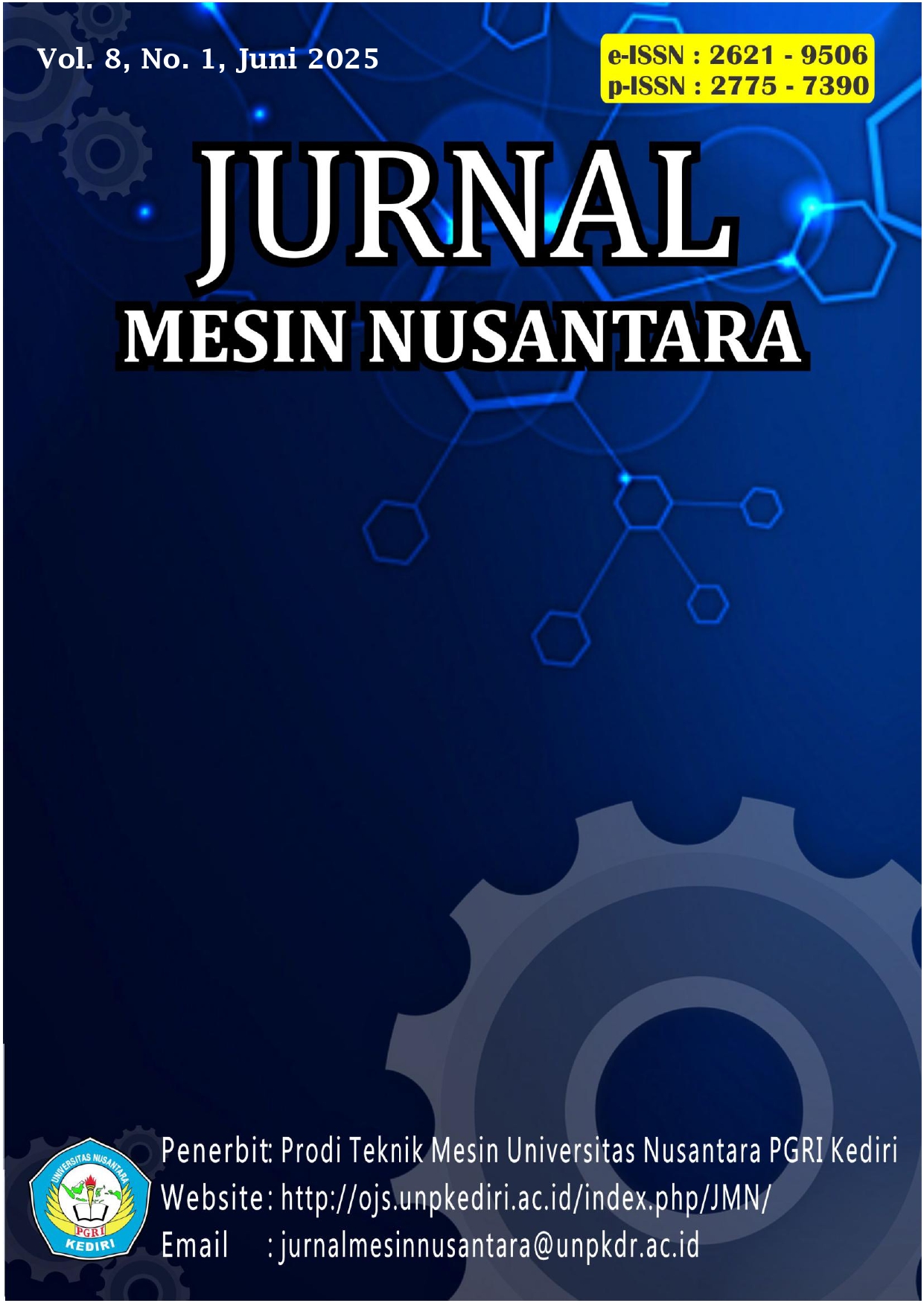Studi Pengaruh Penambahan Alumina (AL2O3) Terhadap Sifat Mekanis dan Konduktifitas Panas Bahan Refraktori Paduan Kaolin dan Ash
DOI:
https://doi.org/10.29407/jmn.v8i1.26047Keywords:
kaolin, fly ash, alumina, konduktivitas, sifat mekanikAbstract
Kaolin adalah material yang tahan terhadap pembakaran pada temperatur tinggi dan fly ash adalah limbah dari proses pembakaran pada boiler. Aluminium oksida (Al2O3), besi oksida (Fe2O3), silikon dioksida (SiO2), kalsium karbonat, belerang dan magnesium merupakan unsur-unsur penyusun fly ash. Penelitian ini bertujuan mengetahui pengaruh paduan kaolin dan fly ash pada sifat mekanik dan kondutifitas panas. Metode yang dilakukan adalah membuat variasi paduan kaolin dan alumina variasi massa alumina (wt%): 0, 5, 10, 15, dan 20. Pengujian yang dilakukan adalah uji konduktivitas panas, kuat tekan, dan impak. Selain itu juga dilakukan uji karakterisasi dengan menggunakan SEM/EDX untuk mengetahui morfologi permukaan, persebaran unsur, dan memastikan unsur yang terkandung didalamnya. Hasil yang didaptkan menunjukkan bahwa penambahan alumina dapat meningkatkan kekuatan tekan namun menurunkan konduktivitas panas dan kekuatan impak. Berdasarkan hasil uji EDX terlihat peningkatan unsur aluminium (Al) silika (Si) dan oksigen (O), namun unsur kalsium (Ca) mengalami penurunan. Uji SEM menunjukan distribusi partikel dari unsur aluminium kalsium dan silika tersebar dan terdapat pori-pori di antara partikel.
Downloads
References
[1] M. Valášková, V. Blahůšková, and J. Vlček, “Effects of kaolin additives in fly ash on sintering and properties of mullite ceramics,” Minerals, vol. 11, no. 8, Aug. 2021.
[2] S. Kamara, W. Wang, and C. Ai, “Fabrication of refractory materials from coal fly ash, commercially purified kaolin, and alumina powders,” Materials (Basel)., vol. 13, no. 15, pp. 1–15, Aug. 2020.
[3] F. S. Irwansyah et al., “Peleburan Kuningan Dengan Teknik Infiltrasi,” J. Zeolit Indones., vol. 9, no. 1, pp. 25–32, 2010.
[4] P. Fernandez-Zelaia et al., “Mechanical Behavior of Additively Manufactured Molybdenum and Fabrication of Microtextured Composites,” Jom, vol. 74, no. 9, pp. 3316–3328, 2022.
[5] T. Pochwała, R. Kusiorowski, A. Śliwa, and B. Psiuk, “Modification of the microstructure of refractory materials by the impregnation process,” Ceram. Int., vol. 47, no. 22, pp. 31843–31851, 2021.
[6] N. A. Abdel-Khalek, K. A. Seiem, S. E. Mohammed, H. H. El-Hendawy, and R. M. Elbaz, “Interaction Between Kaolinite and Staphylococcus Gallinarum Bacteria,” J. Min. World Express, vol. 3, no. 0, p. 46, 2014.
[7] F. S. Aleanizy, F. Alqahtani, O. Al Gohary, E. El Tahir, and R. Al Shalabi, “Determination and characterization of metronidazole-kaolin interaction,” Saudi Pharm. J., vol. 23, no. 2, pp. 167–176, Apr. 2015.
[8] M. F. Brigatti, E. Galán, and B. K. G. Theng, “Structure and Mineralogy of Clay Minerals,” Dev. Clay Sci., vol. 5, pp. 21–81, Jan. 2013.
[9] A. Philip Marthinus, M. D J Sumajouw, and S. W. Reky, “Pengaruh Penambahan Abu Terbang (Fly Ash) Terhadap Kuat Tarik Belah Beton,” J. Sipil Statik, vol. 3, no. 11, pp. 729–736, 2015.
[10] N. S. Yüzbasi, T. Graule, and G. Blugan, “Stability assessment of alumina and SiC based refractories in a high temperature steam environment as potential thermal energy storage materials,” Open Ceram., vol. 16, Dec. 2023.
[11] B. Peng et al., “Preparation of mullite whiskers from high alumina fly ash and its reinforced porous structure,” J. Mater. Res. Technol., vol. 24, pp. 3323–3333, May 2023.
[12] “Cara uji kuat tekan beton dengan benda uji silinder Badan Standardisasi Nasional,” 2011.
[13] Z. Wang, E. Bai, H. Huang, and B. Ren, “Effect of strength grade on mechanical properties of concrete under dynamic load,” Struct. Concr., vol. 24, no. 3, pp. 3646–3655, Jun. 2023.
[14] A. Lianita Sari, “PENGARUH THERMAL SHOCK RESISTENCE DAN KOMPOSISI BAHAN REFRAKTORI TERHADAP KEKUATAN IMPACT DAN STRUKTUR MAKRO.”
[15] M. C. Vera, J. Martinez-Fernandez, M. Singh, V. Casalegno, C. Balagna, and J. Ramirez-Rico, “Microstructure and thermal conductivity of Si-Al-C-O fiber bonded ceramics joined to refractory metals,” Mater. Lett., vol. 276, Oct. 2020.
Downloads
Published
Issue
Section
License
Copyright (c) 2025 Dwi Handoko

This work is licensed under a Creative Commons Attribution-ShareAlike 4.0 International License.
Authors who publish with this journal agree to the following terms:
- Copyright on any article is retained by the author(s).
- The author grants the journal, right of first publication with the work simultaneously licensed under a Creative Commons Attribution License that allows others to share the work with an acknowledgment of the work’s authorship and initial publication in this journal.
- Authors are able to enter into separate, additional contractual arrangements for the non-exclusive distribution of the journal’s published version of the work (e.g., post it to an institutional repository or publish it in a book), with an acknowledgment of its initial publication in this journal.
- Authors are permitted and encouraged to post their work online (e.g., in institutional repositories or on their website) prior to and during the submission process, as it can lead to productive exchanges, as well as earlier and greater citation of published work.
- The article and any associated published material is distributed under the Creative Commons Attribution-ShareAlike 4.0 International License












